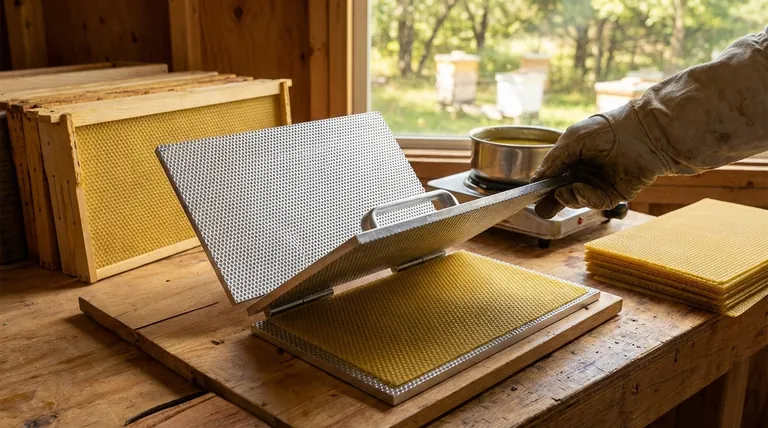At its core, wax foundation is a thin sheet of beeswax imprinted with the hexagonal cell pattern of a honeycomb. Beekeepers install these sheets into wooden frames, providing bees with a pre-made guide to build straight, uniform, and manageable comb within the hive. It is widely considered one of the most significant inventions in modern beekeeping.
The purpose of foundation isn't just to give bees a starting point; it's to impose a specific structure on the hive. This structure is the key to efficient hive inspections, disease management, and modern honey extraction.

The Problem Foundation Solves: Nature's Chaos
To understand why foundation is so critical, you must first understand how bees build without it. Left to their own devices, bees will build comb in any available space, often connecting it between frames or to the walls of the hive itself.
The Challenge of "Wild" Comb
Bees building naturally produce what is called wild comb or burr comb. This comb is often curved, uneven, and attached to multiple surfaces.
This creates a significant problem for the beekeeper. Pulling out a single frame for inspection becomes impossible without tearing the comb, killing brood, and spilling honey.
The Drone Comb Dilemma
Natural comb also tends to have a higher percentage of larger cells built for raising drones (male bees). While drones are necessary for mating, an excessive population consumes valuable hive resources without contributing to honey production or colony tasks.
How Foundation Restructures the Hive
Foundation directly addresses these challenges by giving the bees a clear blueprint. This simple guide has profound effects on the entire hive's operation and the beekeeper's ability to manage it.
A Hexagonal Blueprint for Order
The imprinted hexagonal pattern on a wax foundation sheet provides a powerful suggestion. The bees readily accept this pattern and build their wax cells directly on top of it, resulting in perfectly straight combs contained within the frame.
This allows beekeepers to easily remove, inspect, and return frames without destroying the hive's structure.
Promoting a Productive Workforce
Foundation is typically milled with cell sizes optimized for worker brood (female bees). The queen, measuring the cell with her antennae before laying, is encouraged to lay fertilized eggs that will develop into the worker bees who forage, build comb, and care for the young.
This systematically reduces the amount of drone comb, tilting the hive's demographics toward a more productive workforce.
Enabling Modern Honey Extraction
Straight, sturdy combs are essential for using a centrifugal extractor. This device spins frames at high speed, forcing the honey out without destroying the comb. The bees can then repair and reuse the comb, saving them the immense energy required to build it from scratch.
Understanding the Trade-offs: Wax vs. Plastic
While traditional foundation is made of beeswax, modern beekeeping also relies heavily on plastic alternatives. Each has distinct advantages and disadvantages.
The Case for Traditional Beeswax
Beeswax foundation is the most natural option, as it's made from the same material bees produce themselves. Colonies generally accept and draw out wax foundation more readily than plastic.
The Advantages of Plastic Foundation
Plastic foundation is significantly more durable. It will not warp in high heat or break apart during aggressive honey extraction. It is also resistant to pests like wax moths.
A key benefit of plastic is color. Black plastic foundation makes it much easier to spot tiny white eggs, which is crucial for assessing the queen's health and laying pattern.
The Disadvantages of Plastic
The primary drawback of plastic is that bees can be hesitant to build on it. Many manufacturers coat plastic foundation with a thin layer of beeswax to encourage acceptance, but it can still be slower to be drawn out than pure wax.
Making the Right Choice for Your Hive
Your choice of foundation material depends entirely on your beekeeping philosophy and operational goals.
- If your primary focus is efficiency and durability: Plastic foundation is the superior choice, especially in hot climates or for large-scale operations.
- If your primary focus is brood inspection and health: Black plastic foundation offers the best visibility for spotting eggs and evaluating the queen.
- If your primary focus is a more "natural" approach: Beeswax foundation is the traditional method and is more readily accepted by the colony.
Ultimately, foundation is a tool that allows you to work in partnership with your bees, creating an orderly hive that is healthy, productive, and a pleasure to manage.
Summary Table:
| Feature | Beeswax Foundation | Plastic Foundation |
|---|---|---|
| Material | Pure beeswax | Durable plastic, often wax-coated |
| Acceptance | High - readily accepted by bees | Can be slower, requires encouragement |
| Durability | Can warp in heat, may break | Highly durable, resistant to heat/pests |
| Brood Inspection | Standard visibility | Superior (black plastic shows eggs clearly) |
| Best For | Natural approach, small-scale operations | Efficiency, large-scale operations, hot climates |
Ready to build a more productive and manageable apiary?
At HONESTBEE, we supply high-quality wax and plastic foundation sheets to commercial apiaries and beekeeping equipment distributors. Our wholesale-focused operations ensure you get durable, reliable foundation that promotes straight comb construction, efficient hive inspections, and maximum honey production.
Let us help you create the orderly, productive hives your business depends on. Contact our wholesale team today to discuss your foundation needs and place your order!
Visual Guide

Related Products
- Notebook Style Beeswax Foundation Mould Wax Foundation Mold
- Manual Beeswax Comb Foundation Machine Wax Foundation Mill Embossing Machine
- Beeswax Foundation Sheets Beehive Foundation for Wholesale
- Professional Frame Preparation: The HONESTBEE Electric Wire Embedder
- Food Grade Plastic bee Foundation for Bee Frames
People Also Ask
- What are the uses of recycled beeswax cappings? Transform Honey Byproducts into Valuable Assets
- How is beeswax foundation secured in wooden frames? Ensure Strong Comb for Healthy Hives
- Can beeswax foundation be recycled or reused? A Guide to Sustainable Beekeeping
- How do you use the Foundation Mold to create beeswax foundation? Master DIY Beekeeping with Precision
- What is beeswax foundation made of? A Guide to Stronger, More Efficient Hives



















